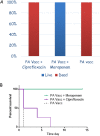Treating Anthrax-Induced Meningitis in Rabbits
- PMID: 29661872
- PMCID: PMC6021664
- DOI: 10.1128/AAC.00298-18
Treating Anthrax-Induced Meningitis in Rabbits
Abstract
Treatment of anthrax is challenging, especially during the advanced stages of the disease. Recently, the Centers for Disease Control and Prevention (CDC) updated its recommendations for postexposure prophylaxis and treatment of exposed populations (before and after symptom onset). These recommendations distinguished, for the first time, between systemic disease with and without meningitis, a common and serious complication of anthrax. The CDC considers all systemic cases meningeal unless positively proven otherwise. The treatment of patients suffering from systemic anthrax with suspected or confirmed meningitis includes the combination of three antibiotics, i.e., a fluoroquinolone (levofloxacin or ciprofloxacin), a β-lactam (meropenem or imipenem), and a protein synthesis inhibitor (linezolid or clindamycin). In addition, treatment with an antitoxin (anti-protective antigen antibodies) and dexamethasone should be applied. Since the efficacy of most of these treatments has not been demonstrated, especially in animal meningitis models, we developed an anthrax meningitis model in rabbits and tested several of these recommendations. We demonstrated that, in this model, ciprofloxacin, linezolid, and meropenem were ineffective as single treatments, while clindamycin was highly effective. Furthermore, combined treatments of ciprofloxacin and linezolid or ciprofloxacin and dexamethasone failed in treating rabbits with meningitis. We demonstrated that dexamethasone actually hindered blood-brain barrier penetration by antibiotics, reducing the effectiveness of antibiotic treatment of anthrax meningitis in this rabbit model.
Keywords: Bacillus anthracis; anthrax; antibiotic; ciprofloxacin; clindamycin; dexamethasone; linezolid; meningitis; meropenem; rabbits.
Copyright © 2018 American Society for Microbiology.
Figures








References
-
- Hanna P. 1998. Anthrax pathogenesis and host response. Curr Top Microbiol Immunol 225:13–35. - PubMed
MeSH terms
Substances
LinkOut - more resources
Full Text Sources
Other Literature Sources
Medical
Molecular Biology Databases

